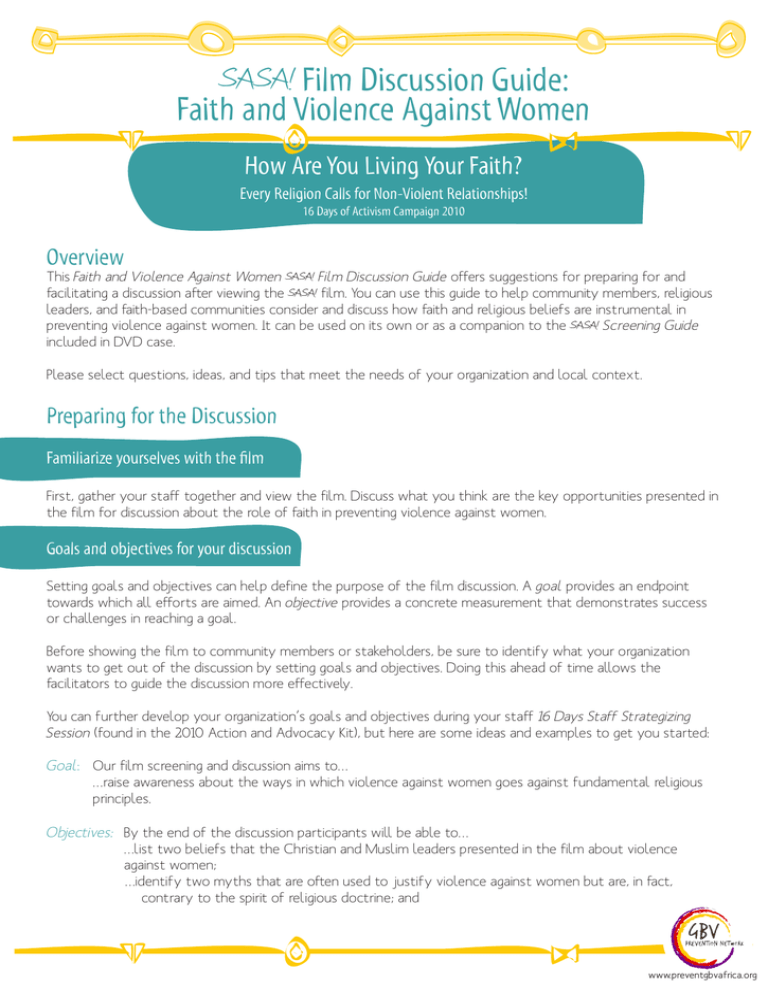SASA!Film Discussion Guide: Faith and
advertisement

SASA! Film Discussion Guide: Faith and Violence Against Women How Are You Living Your Faith? Every Religion Calls for Non-Violent Relationships! 16 Days of Activism Campaign 2010 Overview This Faith and Violence Against Women SASA! Film Discussion Guide offers suggestions for preparing for and facilitating a discussion after viewing the SASA! film. You can use this guide to help community members, religious leaders, and faith-based communities consider and discuss how faith and religious beliefs are instrumental in preventing violence against women. It can be used on its own or as a companion to the SASA! Screening Guide included in DVD case. Please select questions, ideas, and tips that meet the needs of your organization and local context. Preparing for the Discussion Familiarize yourselves with the film First, gather your staff together and view the film. Discuss what you think are the key opportunities presented in the film for discussion about the role of faith in preventing violence against women. Goals and objectives for your discussion Setting goals and objectives can help define the purpose of the film discussion. A goal provides an endpoint towards which all efforts are aimed. An objective provides a concrete measurement that demonstrates success or challenges in reaching a goal. Before showing the film to community members or stakeholders, be sure to identify what your organization wants to get out of the discussion by setting goals and objectives. Doing this ahead of time allows the facilitators to guide the discussion more effectively. You can further develop your organization’s goals and objectives during your staff 16 Days Staff Strategizing Session (found in the 2010 Action and Advocacy Kit), but here are some ideas and examples to get you started: Goal: Our film screening and discussion aims to… …raise awareness about the ways in which violence against women goes against fundamental religious principles. Objectives: By the end of the discussion participants will be able to… …list two beliefs that the Christian and Muslim leaders presented in the film about violence against women; …identify two myths that are often used to justify violence against women but are, in fact, contrary to the spirit of religious doctrine; and www.preventgbvafrica.org …give one example of how both Mama Joyce and Josephine used their faith to be resilient and act against violence against women. Goal: Our film screening and discussion aims to… …create a critical, interfaith dialogue in the community about violence against women prevention Objectives: By the end of the discussion participants will be able to… …identify two similarities between the way Christianity and Islam (and others) view violence against women; and …identify at least one way in which they agree or disagree with the Anglican priest and the Muslim imam in the film and why. Selecting the questions Once you have watched the film and identified your organization’s goals and objectives for the discussion, it is time to select the questions. You can develop your own and/or choose the best-suited questions from the list below: Discussion Questions 1) In the film both the priest and imam condemned violence against women. Do you agree? Why or why not? 2) Mama Joyce says that everyone in her community knew she was being beaten by her husband. What obligation do you think your community of faith has to take action in situations such as these? 3) Josephine joins a support group for HIV positive people. Mama Joyce leads a discussion group for women experiencing violence. Charles talks about the hopelessness he felt when he learned he was HIV positive and remarks that reinforcement from others was essential to rebuilding his hope. What ways your religion can support people who have been affected by violence and HIV? 4) How does your faith give purpose to your life? Are there ways that your faith can empower you and others to prevent violence against women? How? 5) In the film, Rev. Canon Gideon argues that religious leaders need to review and reinterpret scripture and theology so that women are valued and not abused. Do you agree? Why or why not? 6) Sheikh Idriis encourages couples to balance power. Do you agree? Why or why not? Are there ways that your community of faith can encourage this? 7) What are some important concepts or passages in your religion or community of faith that oppose violence against women? 8) What are some of the justifications used for violence against women in your religious community? Do you agree? Disagree? What are some ways to legitimately refute these justifications? 9) How will you use your faith and religious beliefs to prevent violence against women? 10)How can your community of faith more actively prevent and respond to violence against women? We suggest that after you have selected the questions, sit together as a staff to discuss basic ‘answers’ to them. These can be used by facilitators to guide the discussion. While it will not be your goal to have your community members produce these answers exactly, it will help the facilitators meet the goals and objectives organizing the discussion. To read more about the film and for general tips on organizing a film screening, see the SASA! Screening Guide inside the DVD case.
